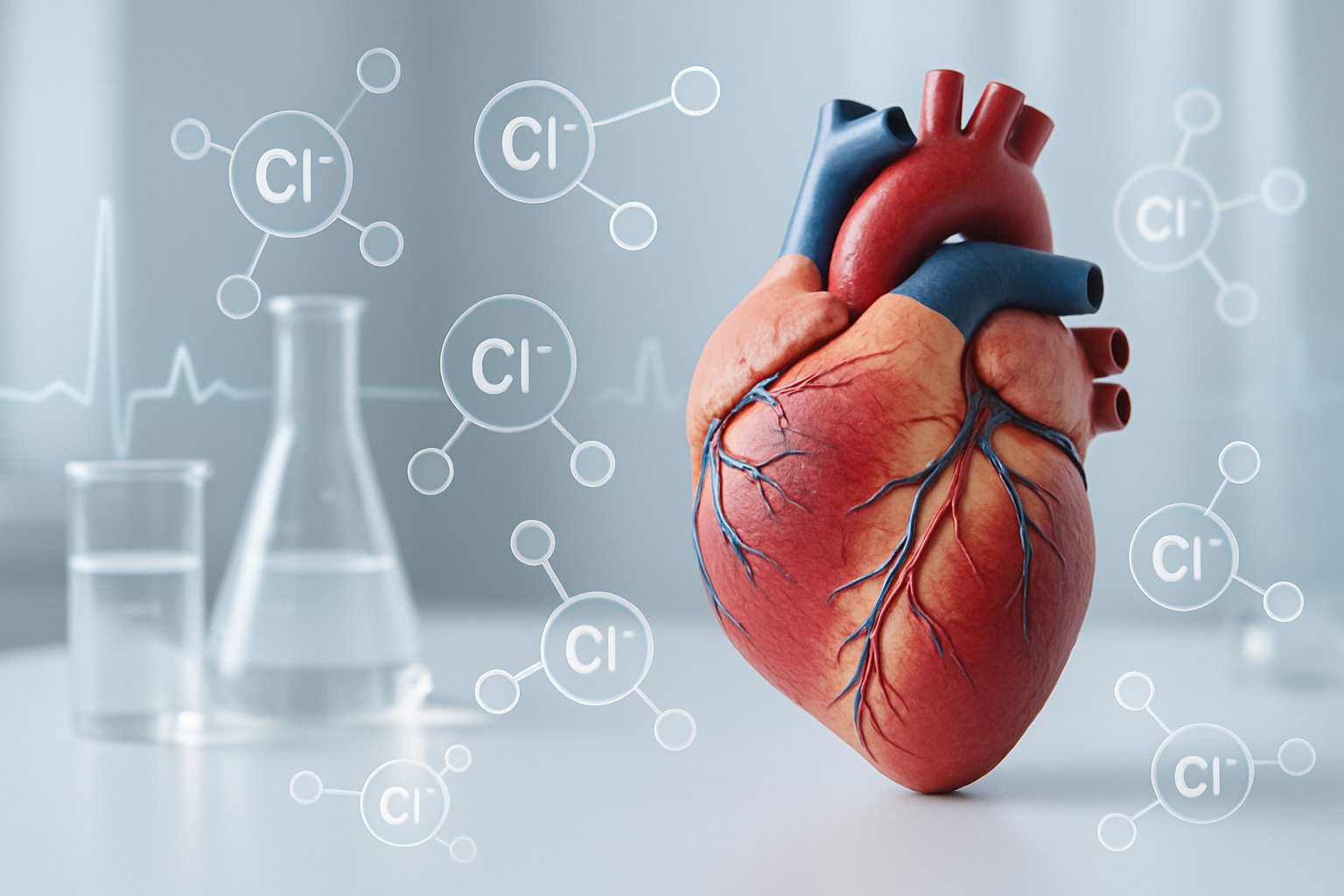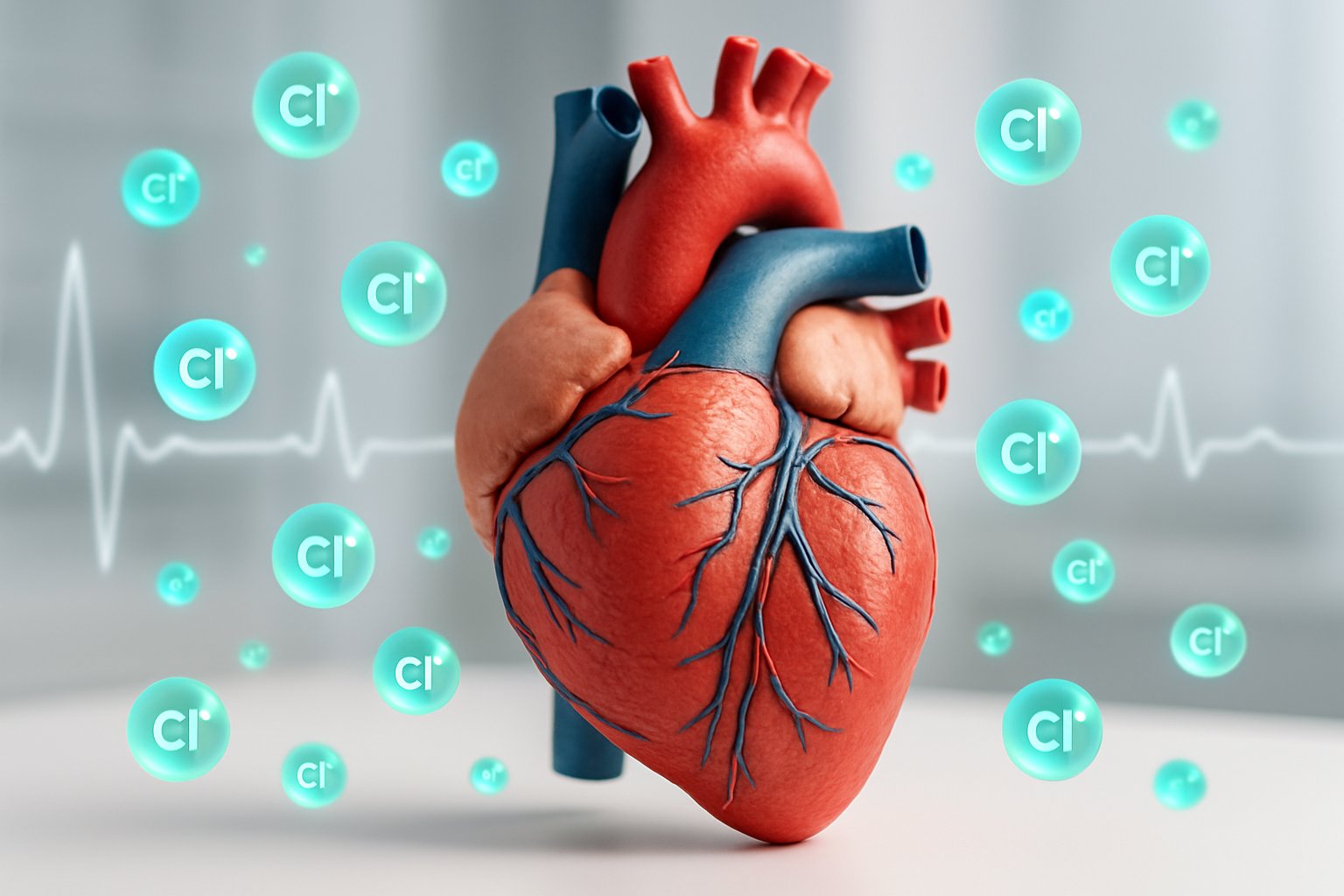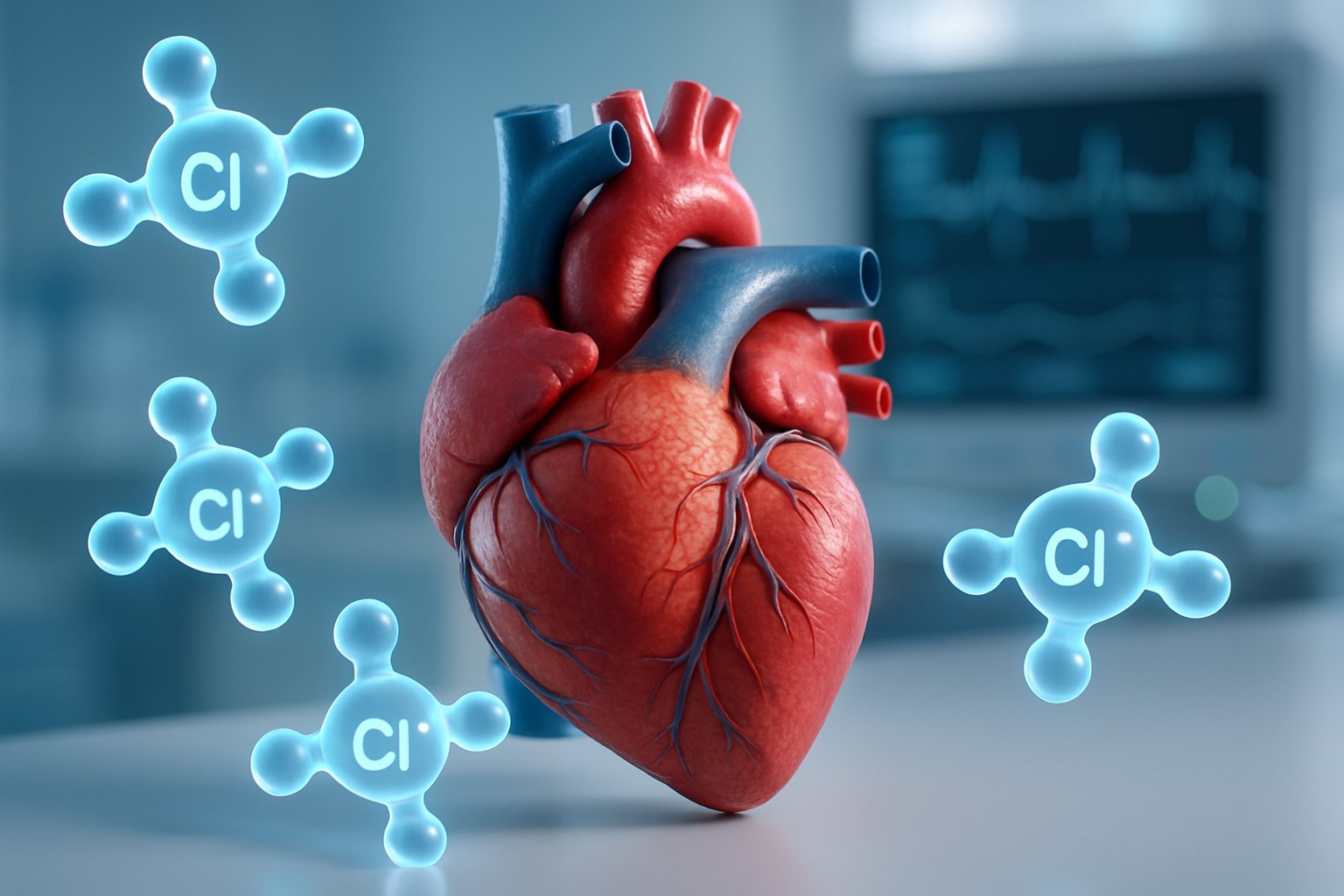Chloride imbalances, especially low levels, can predict worse outcomes in heart failure patients better than sodium levels. Both high and low chloride affect the heart’s electrical system and can lead to dangerous irregular heartbeats. Chloride plays a key role in how well heart failure treatments work and affects fluid balance in the body.
Your heart relies on a delicate balance of electrolytes to function properly, and chloride plays a more important role than many people realize. While doctors have long focused on sodium and potassium levels, recent research shows that chloride imbalances can significantly impact heart health and may be even more predictive of heart problems than other electrolytes.

Both high and low chloride levels can negatively affect heart function, with low chloride being particularly dangerous for people with heart failure. Studies have found that hypochloremia is an independent predictor of adverse outcomes[1] in patients with acute or chronic heart failure. High chloride levels can also cause problems by affecting the electrical activity of heart cells and contributing to irregular heartbeats.
Understanding how chloride affects your heart is crucial for anyone concerned about cardiovascular health. The relationship between chloride and heart function involves complex interactions with fluid balance, hormone systems, and the heart’s electrical activity that can determine whether treatments work effectively.
How High Chloride Affects Cardiac Function

High chloride levels disrupt normal heart muscle cell activity by altering electrical signals and pH balance. These changes can reduce the heart’s pumping ability and trigger dangerous irregular heartbeats.
Role in Heart Muscle Excitability
Chloride ions play a crucial role in maintaining proper electrical activity in heart muscle cells. When chloride levels become too high, the chloride ion concentration affects how easily heart cells can generate electrical signals.
High chloride disrupts the normal flow of ions across cell membranes. This disruption changes the resting electrical charge of heart muscle cells. The altered electrical environment makes it harder for cells to respond properly to signals.
The intracellular pH becomes more acidic when chloride levels rise. This pH change affects proteins that control muscle contraction. Heart muscle cells cannot contract as effectively when their internal environment becomes too acidic.
With-no-lysine protein kinases (WNK) help regulate chloride transport in cells. High chloride levels can overwhelm these regulatory systems. When WNK proteins cannot maintain proper chloride balance, heart muscle function suffers.
Impact on Cardiac Output and Contractility
Elevated chloride directly reduces how forcefully the heart can pump blood. Cardiac output decreases when heart muscle cells cannot contract with normal strength.
High chloride levels interfere with calcium handling inside heart cells. Calcium is essential for muscle contraction. When chloride disrupts calcium movement, the heart cannot squeeze blood effectively.
The heart’s ability to fill with blood also becomes impaired. High chloride affects the relaxation phase of the heartbeat. Poor relaxation means less blood enters the heart between beats.
Blood pressure regulation becomes more difficult with elevated chloride. The heart must work harder to maintain adequate blood flow. This extra workload can further damage cardiac function over time.
Arrhythmias and Electrical Activity Disruptions
High chloride creates conditions that promote dangerous arrhythmias. The altered electrical environment makes abnormal heart rhythms more likely to occur.
Chloride changes how electrical signals spread through the heart. Normal rhythm depends on signals moving in a coordinated pattern. High chloride disrupts this coordination and creates chaotic electrical activity.
Research shows that chloride abnormalities can cause dysregulation of myocyte intracellular pH, which is an arrhythmogenic factor[1]. This pH disruption directly contributes to life-threatening rhythm problems.
The heart’s natural pacemaker becomes unstable with high chloride levels. Irregular signals from the pacemaker create unpredictable heart rates. These rhythm disturbances can lead to sudden cardiac death in severe cases.
Chloride Imbalance and Heart Failure Outcomes

Low chloride levels show strong links to poor outcomes in heart failure patients. Hypochloremia serves as an independent predictor[1] of death and hospital readmission across different types of heart failure.
Electrolyte Imbalances and Prognosis
Serum chloride acts as a stronger predictor of outcomes than sodium[1] in heart failure patients. Studies show hypochloremia occurs in about 25-30% of hospitalized heart failure patients.
Normal chloride levels range from 96-105 mmol/L. Values below 96 mmol/L define hypochloremia and link to worse outcomes.
Research involving over 25,000 patients shows consistent patterns. Each 1 mmol/L decrease in chloride increases death risk by 4-6%. The lowest quartile of chloride levels shows a 2-fold higher mortality risk.
Key prognostic findings include:
- 30-day readmission rates increase by 35% with hypochloremia
- In-hospital mortality drops significantly when chloride levels improve
- Progressive hypochloremia during treatment shows the worst outcomes
Persistent low chloride during hospital stays predicts 9 times higher heart failure death rates. Even mild decreases affect prognosis significantly.
Links to Heart Failure Types (HFpEF, HFrEF)
Both heart failure with reduced ejection fraction (HFrEF) and heart failure with preserved ejection fraction (HFpEF) show similar chloride-related outcomes. Studies in HFpEF patients demonstrate that each 4.05 mmol/L decrease in serum chloride increases 5-year death risk by 29%[1].
HFrEF patients show comparable patterns. Post-heart attack patients with HFrEF face higher mortality when chloride drops below 100 mmol/L.
Differences between HF types:
- HFpEF: Chloride mainly affects cardiovascular death (51% increase per 4 mmol/L drop)
- HFrEF: Links more strongly to hospital readmissions and diuretic resistance
The chloride-mortality relationship remains independent of ejection fraction. Both preserved and reduced ejection fraction groups benefit from chloride monitoring.
Advanced heart failure patients show the strongest associations. Those requiring heart transplant or mechanical support face 6% higher risk per 1 mmol/L chloride decrease.
Neurohormonal & RAAS System Influence
Chloride levels directly affect plasma volume, vasopressin secretion, and renin-angiotensin-aldosterone system activity[1]. These changes happen primarily through chloride, not sodium levels.
Low chloride triggers RAAS activation more strongly than sodium changes. This leads to increased aldosterone and renin activity. Vasopressin release also increases with hypochloremia.
The neurohormonal cascade affects fluid balance significantly. Patients with chloride below 96 mmol/L show 7 times worse diuretic response. This creates treatment resistance.
RAAS system effects include:
- Increased plasma renin activity with low chloride
- Higher aldosterone production
- Reduced response to loop diuretics
- Worsened fluid retention
B-type natriuretic peptide (BNP) levels correlate with chloride status. Lower chloride often accompanies higher BNP values in decompensated patients.
Clinical Implications for Mortality and Prognosis
Multiple studies across different populations confirm hypochloremia as an independent mortality predictor[2]. This relationship persists after adjusting for other electrolytes and heart failure severity.
Mortality patterns vary by chloride levels:
| Chloride Level | 30-Day Mortality Risk | 1-Year Mortality Risk |
|---|---|---|
| >105 mmol/L | Baseline | Baseline |
| 96-105 mmol/L | +15% | +20% |
| <96 mmol/L | +40% | +60% |
Hospital readmission rates increase substantially with low chloride. Patients with admission or discharge hypochloremia face 35% higher 30-day readmission rates[1].
Cardiology teams now recognize chloride monitoring as essential. Serial measurements during treatment provide better prognostic information than single values.
The timing of chloride changes matters significantly. Persistent hypochloremia shows worse outcomes than temporary drops. Progressive decreases during treatment indicate the highest mortality risk.
Frequently Asked Questions

Chloride affects heart function through multiple pathways including electrical activity, fluid balance, and medication interactions. Understanding these mechanisms helps clarify how chloride imbalances can lead to serious cardiovascular complications.
What are the impacts of elevated chloride levels on cardiovascular health?
High chloride levels can disrupt the heart’s electrical system. This disruption affects how the heart beats and maintains its rhythm.
Elevated chloride changes the membrane potential in heart cells. These changes can alter how long each heartbeat lasts and affect the heart’s natural pacemaker.
Chloride abnormalities can cause arrhythmias[1] by affecting cellular excitability in the cardiovascular system. The imbalance creates instability in the heart’s electrical signals.
Hyperchloremia may contribute to sudden cardiac death. This happens when the electrical disruption becomes severe enough to stop normal heart function.
Can an imbalance of electrolytes, including chloride, lead to heart complications?
Electrolyte imbalances directly affect heart muscle function. Chloride works with other electrolytes like sodium and potassium to maintain proper heart rhythm.
When chloride levels are too high or too low, the heart muscle cells cannot function normally. This can lead to irregular heartbeats or arrhythmias.
The imbalance affects intracellular pH levels in heart muscle cells. Dysregulation of myocyte intracellular pH is an arrhythmogenic factor[1] that increases the risk of dangerous heart rhythms.
Heart failure patients show a 50% decline in chloride transfer proteins. This adaptive change makes the heart more prone to electrical instability.
How does hyperchloremia contribute to hypertensive disorders?
High chloride levels affect fluid retention in the body. When chloride is elevated, the body tends to hold onto more water and sodium.
This fluid retention increases blood volume. More fluid in the blood vessels puts extra pressure on artery walls.
Chloride plays an important role in fluid homeostasis[1] and affects how the kidneys handle salt and water. When this system is disrupted, blood pressure can rise.
The renin-angiotensin system responds to chloride changes. This hormone system controls blood pressure and can become overactive when chloride levels are high.
In what ways can chloride imbalances interact with cardiac medications?
Diuretic medications directly affect chloride levels in the blood. Diuretic agents cause higher urinary chloride excretion and consequently serum hypochloremia[1].
Low chloride levels can reduce how well diuretics work. Hypochloremia itself can initiate and exacerbate diuretic resistance[1] in heart failure patients.
Patients taking heart medications need regular chloride monitoring. Changes in chloride levels may require adjusting medication doses or types.
Some heart failure treatments may cause chloride abnormalities. Doctors must balance treating the heart condition while managing electrolyte levels.
What preventive measures can mitigate the risk of chloride-related heart issues?
Regular blood tests help monitor chloride levels before problems develop. Early detection allows for quick treatment adjustments.
Maintaining proper fluid balance reduces chloride fluctuations. This includes following prescribed fluid restrictions when recommended by doctors.
Medication compliance helps prevent sudden changes in chloride levels. Taking prescribed medications as directed keeps electrolytes more stable.
Working with healthcare providers to adjust treatments prevents dangerous imbalances. Chloride abnormalities may be managed through a number of medical therapies[1].
How does the body regulate chloride levels and its implications for heart function?
The kidneys control most chloride regulation in the body. They adjust how much chloride gets removed through urine based on body needs.
Hormonal systems also influence chloride balance. The renin-angiotensin-aldosterone system responds to chloride changes and affects heart function.
Changes in plasma volume, vasopressin secretion, and renin-angiotensin-aldosterone systems are purported to be primarily mediated by serum chloride[1]. This makes chloride central to cardiovascular health.
When regulation fails, the heart suffers direct consequences. Poor chloride control leads to fluid imbalances and electrical problems in heart tissue.
References
- Just a moment.... https://www.jacc.org/doi/10.1016/j.jchf.2021.07.006 Accessed October 25, 2025
- Just a moment.... https://karger.com/crm/article/11/2/87/86691/The-Role-of-Serum-Chloride-in-Acute-and-Chronic Accessed October 25, 2025
